If you are new to the world of antiques and collector’s glass, you might wonder what color has to do with carnival glass. The glass comes in so many variations that color may seem unimportant. However, color is one of the most defining features of carnival glass.
Carnival glass comes in dozens of colors, from amber and marigold to smoke and amethyst. A piece of carnival glass that has a rare color can be sold for thousands of dollars. The color that matters isn’t the color of the glaze on the outside of the glass, but rather the color of the glass itself.
Here is a guide to carnival glass color.
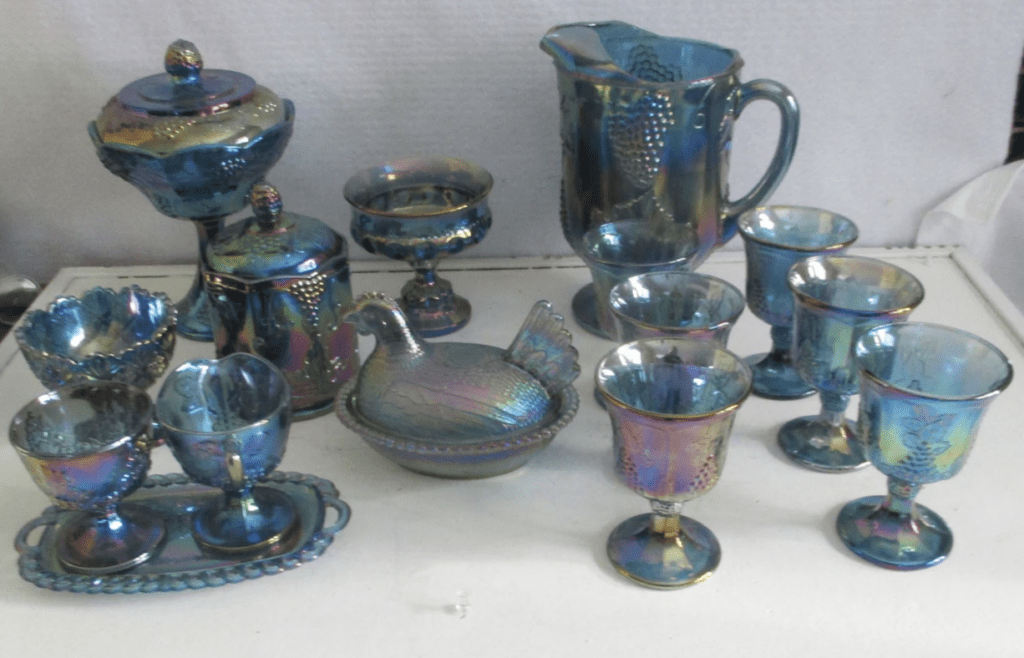
Carnival Glass History and Value
At the start of the 20th century, new manufacturing methods were changing the world. Materials that were once uncommon were becoming available to everyone. Among these materials was glass. Thanks to new machines and techniques, glass was becoming mass-produced and put in people’s homes. Also, thanks to the now simple process of making glass, new things could be done with the material.
Artists and designers began to shape and color glass to be used as decorative pieces. Because glassmaking was cheap, these pieces were affordable for just about everyone. Heavily worked and designed glass was displayed in fairs and art galleries, with new pieces sporting vibrant colors that caught the eye.
To take advantage of the demand in the market for this colored glass, the Fenton Art Glass Company began to mass-produce colored glass. Their techniques for coloring the glass and covering it with multicolored glaze allowed them to make large quantities of the glass that was in such high demand while not spending too much on the creation.
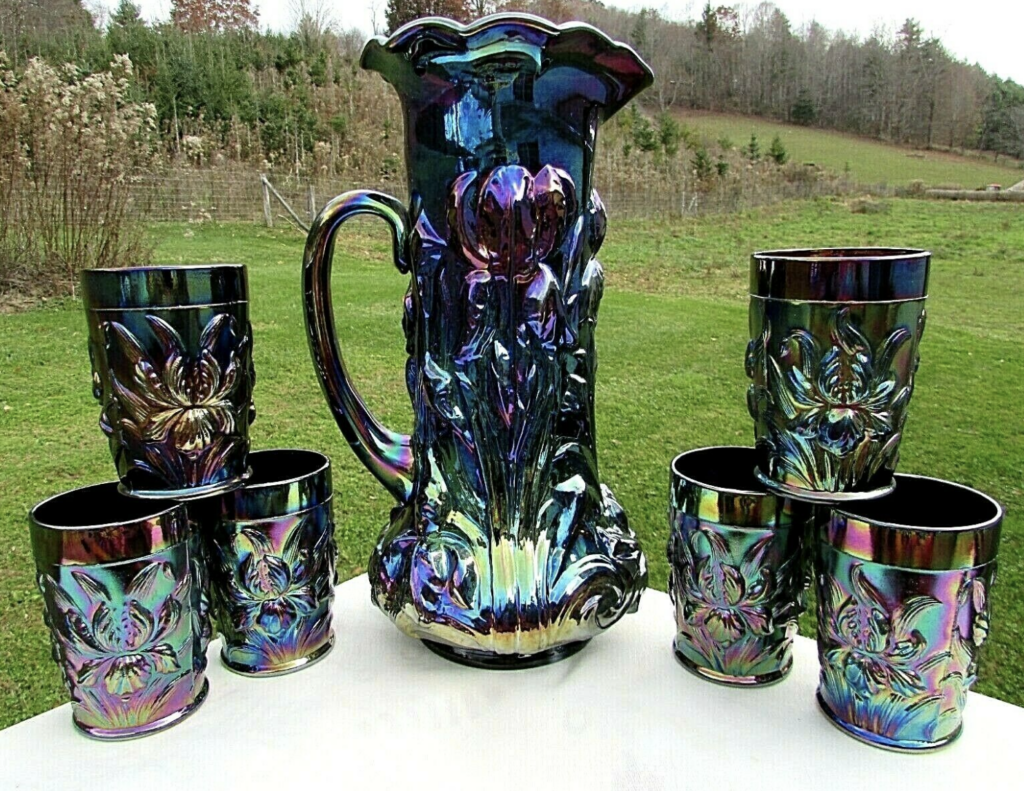
Unfortunately, this glass company was unable to sell their glass for the same price that some of the more prestigious glass creators were selling theirs for. As a result, the value of Fenton’s colored glass dropped. Pieces of Fenton’s colored art glass were given away as prizes at carnivals around the United States, eventually earning the glass its nickname, carnival glass.
The Fenton Art Glass Company made the majority of their carnival glass before 1925, though a few sets continued to be manufactured through the 1930s. New styles and colors of glass were used to try to catch more interest, but eventually, production stopped. Today, carnival glass is worth much more as a collector’s item, with the rarest colors of glass dramatically raising a piece’s value.
The more vibrant the glass is, the more valuable it will be. Clear carnival glass is relatively common and not very valuable. However, rare colors like dark purple and cherry red are rare and extremely valuable.
Check out our full article on Carnival Glass Valuation to see how much carnival glass is worth.
Color Origin
The glass pieces that today are known as carnival glass consists of a colored glass base topped with a multicolored glaze. The glaze is often worked in patterns and designs, and comes in an infinite amount of colors, as all you need to do to color the glaze is add a new type of dye. The color of the glass base, however, cannot be so easily created.
The glass used in carnival glass gets its color from the use of metallic salts that the various decorative glass companies pressed into the glass while it was being created and shaped. Elements such as sulfur, iron, boron, and nickel can be used to create colors ranging from yellow to red to blue to purple and even smoky black.
The color that forms the base of a piece of carnival glass does a lot to influence the final look of a piece. Different colors of glass also impacted the purpose of some carnival glass, whether the glass was to be used for special plates and cups or if it was to be purely for decoration in the form of a large bowl or plate to be hung on a wall.
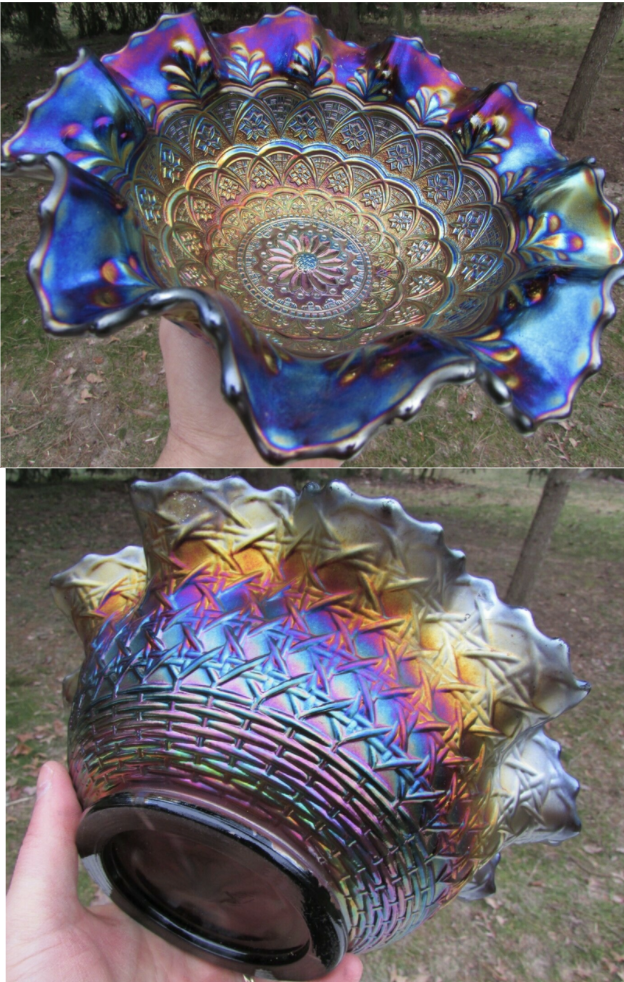
If you have a piece of depression glass and want to know about how much it is worth, the main factor is what kind of a piece it is. Decorative vases, pitchers, and platters are the most valuable, though complete sets of carnival glass are also extremely expensive. Larger glass pieces are worth more, as are older ones.
The other main factor in a piece of carnival glass’s worth is the glass color. You can check the color of the glass underneath the glaze by finding a part of the glass that isn’t covered by the glaze and shining a strong light behind it. This should help you quickly identify what color your glass is and how much it might be worth. Here’s a look at some of the most common and most valuable colors in carnival glass.
Amber
Carnival glass with an amber color is one of the most appealing types of glass. Amber-colored carnival glass generally covers every shade from yellow to brown. Though there are classifications within the color amber (such as root beer and horehound), Amber has a classification of its own.
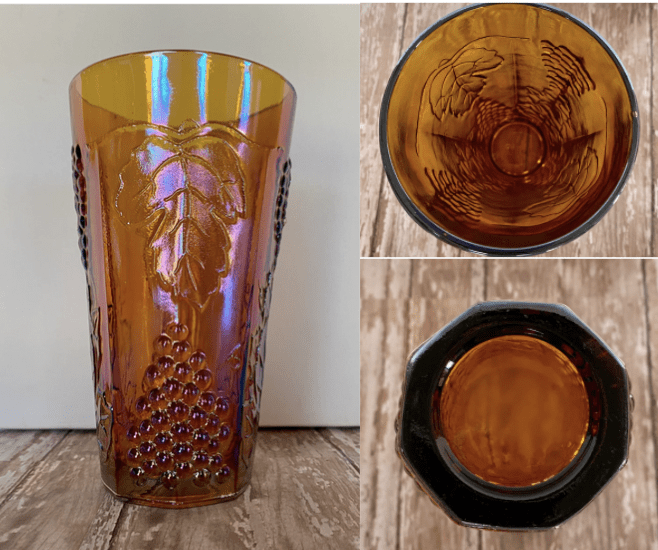
Amber carnival glass is one of the more common colors of glass, despite it not being one of the original colors that glassmakers tried to produce. Amber glass generally came from red glass that hadn’t taken the appropriate color. Because of this, many of the amber pieces of carnival glass feature the designs and patterns that are commonly found on red carnival glass.
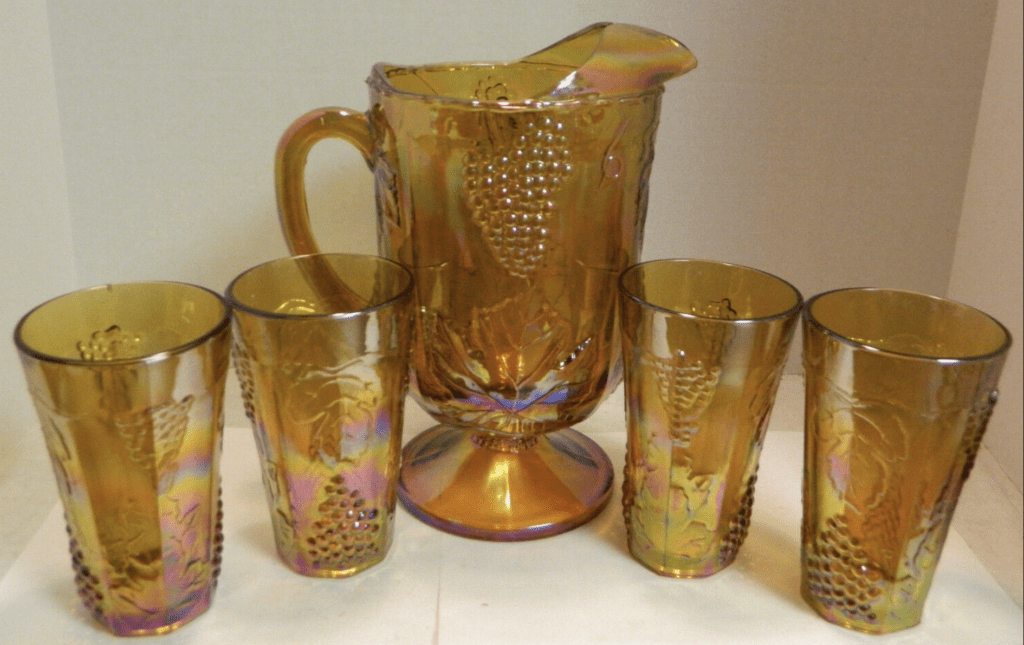
You can generally buy or sell amber carnival glass for the typical price of 20-50 dollars per piece, depending on the size, pattern, and condition of the carnival glass.
Amethyst
Amethyst carnival glass encompasses the majority of deep purple hues that are occasionally found in carnival glass. Amethyst was most commonly used to make decorative plates and bowls, as the minerals needed to make the deep purple of amethyst weren’t as common or as cheap as some of the other components needed for other colors.
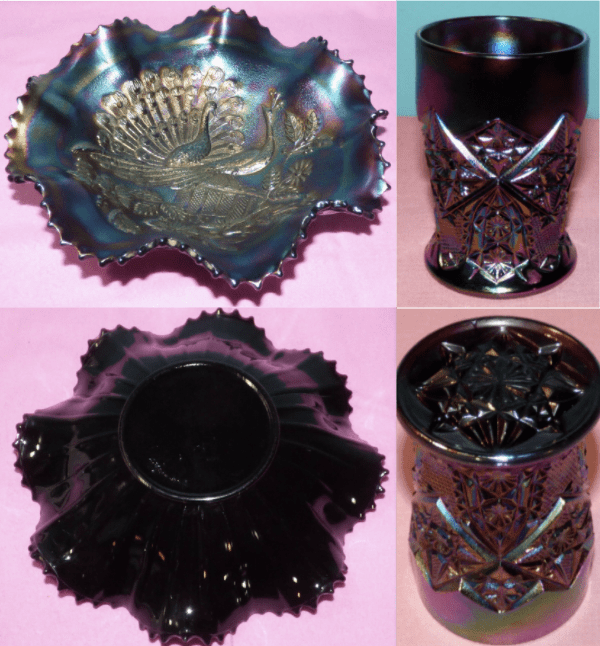
On the right: Fenton Carnival Glass Amethyst Hobstar Tumbler $11. Both pieces from dclipse03 on Ebay
Because it is less common, amethyst carnival glass can be extremely valuable. Generally, the darker the shade of purple that you have, the more valuable the piece is. Some smaller plates that feature a peacock design are pretty valuable to collectors. You can also find purple carnival glass that has been shaped to make rabbit or bird figurines.
Lavender carnival glass is one of the variants of amethyst, characterized by its clearer color. Some versions of lavender carnival glass appear almost yellow or green, so be sure to shine a bright light through a spot with no glaze to determine exactly what shade of glass you have. Depending on the shade, amethyst, purple, and lavender carnival glass are worth 30-60 dollars, though some pieces can be worth well over $100 if they are dark enough.
Blue
Blue is another one of the most common colors in carnival glass because of the range of shades that it offers. Among the blue carnival glass colors, there are ice blue, celeste, sapphire, electric blue, aqua, and more. The reason for these color ranges is that several minerals can create a blue color in the glass, including boron and cobalt.
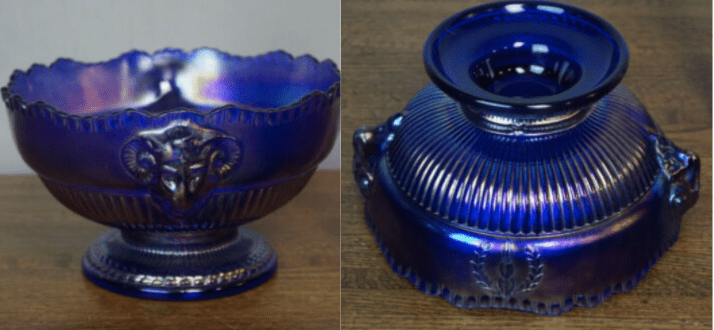
Blue carnival glass makes popular plates, bowls, cups, and vases. The glazes and designs on these pieces do a lot to bring out the personality of a piece, though some cups and plates use no glaze at all, preferring the natural color of the glass. The most common blue pieces of carnival glass are cups, though there are some novel pieces like butter dishes and the like that can be valuable.
Generally, the value of a blue piece of carnival glass depends on the features that are unique to the piece itself. Blue glass can be very valuable, but the majority of pieces are only worth around 20-40 dollars. Though the color is striking, it is a common one so it doesn’t get as much attention as some of the rarer colors.
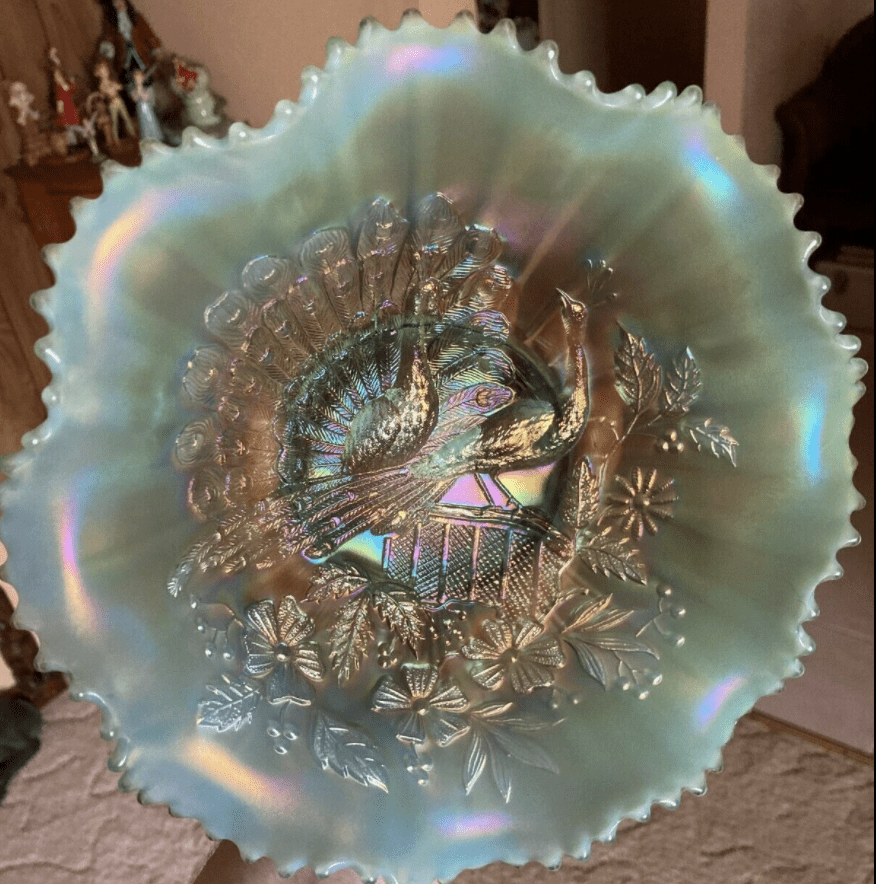
Green
Green is one of the colors that is least often found in carnival glass, making it one of the more valuable colors. Everything from emerald green to olive-green exists, but most manufacturers of these colors only made a few sets and pieces. The most common colors are the darker greens, but a few pale and icy greens can be found.
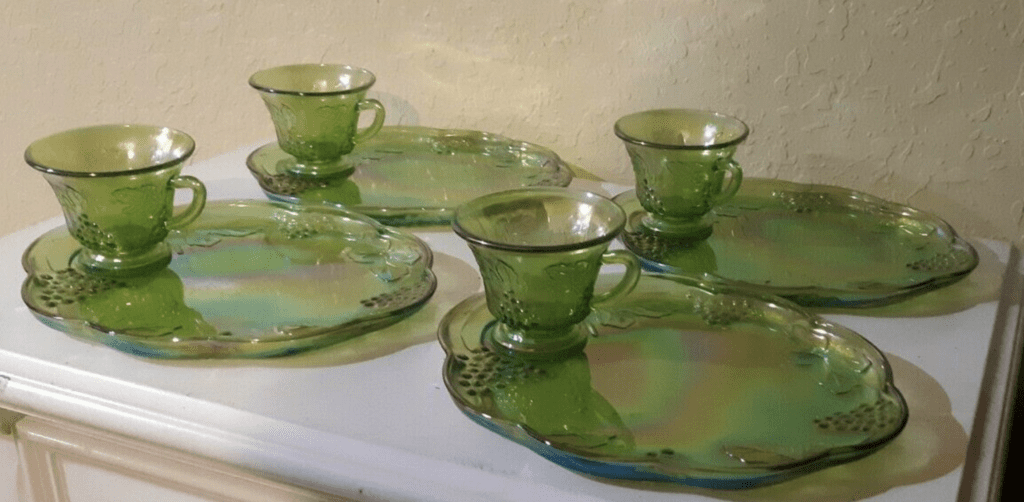
Green carnival glass can be extremely valuable because of its rarity. In fact, ice green is one of the colors of carnival glass that is most valuable. This comes from the fact that green colors were very difficult to mix for most manufacturers.
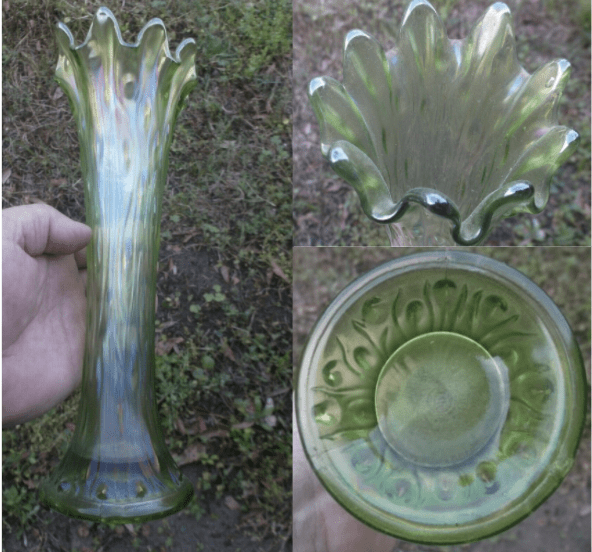
The iridescent color of ice green makes it a valuable collector’s item that can be in very high demand. Other green colors are also much less common than the most popular tones of carnival glass like marigold, so you can generally expect any green piece to be worth around 40-60 dollars, with some of the rarest colors and pieces being worth much more.
Marigold
Marigold is the color of carnival glass that is most commonly found around the world. The color is easy to create and to mix, and it draws plenty of attention for its brightness and shine. Marigold comprises the colors from orange to yellow but is also the color of glass that is used to make up the majority of clear glass pieces. If a carnival glass dish was made to be mostly clear, chances are it uses marigold as its only color.
One of the reasons that marigold is such a popular and definitive color of carnival glass is because it was the closest thing that most makers could get to the color red without having to go through the painstaking process that red carnival glass usually requires. Furthermore, the marigold color comes from iron, which means that marigold glass was cheap and always available.
Because of the high quantity of carnival glass in the marigold color, you might have a difficult time selling a piece for more than 20 dollars. Unless you have an extremely large bowl or serving dish of top quality, you probably won’t get very much for it.
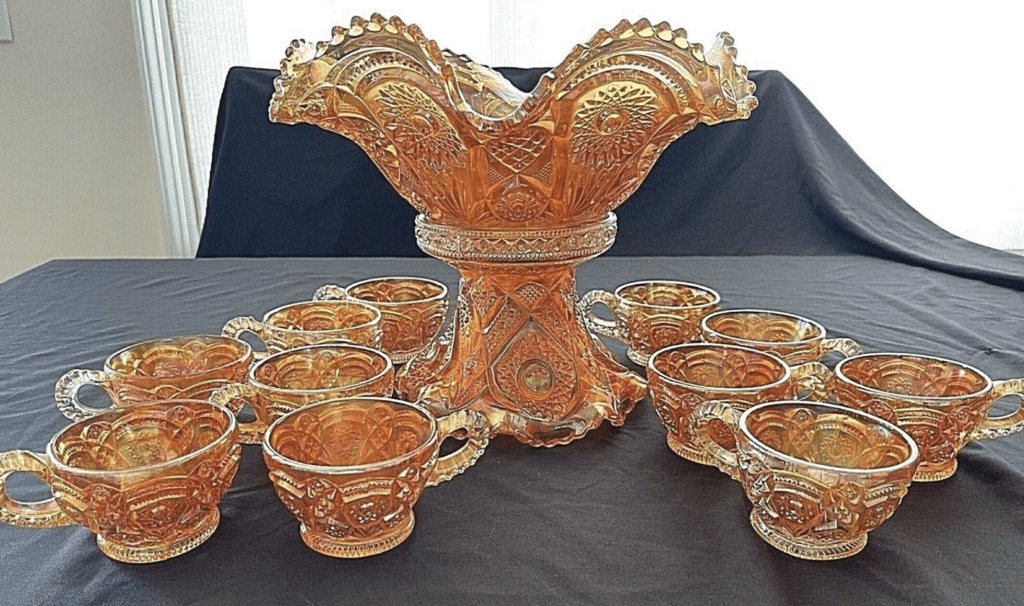
Smoke
While most people might think of smoke-colored carnival glass as simple greys and maybe blacks, the reality is that most pieces of smoke-colored carnival glass are infused with other colors ranging from green to yellow to purple.
These colors can be seen only when a bright light reveals them through the smoke-colored carnival glass and can come as a surprise to people who thought that there wasn’t much to a piece of smoke carnival glass.
Because of the many colors that can go into making a piece of smoke-colored carnival glass, this color of glass can be very valuable. Furthermore, it isn’t particularly common of a color, which raises its value. Many pieces are worth around 40 dollars to collectors, but some dishes and sets can be worth much more than that.

Red
Red carnival glass is easily one of the rarest colors that you can find. Most glassmakers had a lot of trouble with the color, as the only true reds came from a process that was slow and arduous compared to other colors of carnival glass.
If any mistakes were made during the creation, the red glass would come out brittle and in a bad color. Furthermore, with marigold being an easy alternative that approximated reds, most glassmakers only made a few pieces of red carnival glass.
It is rare for a piece of red carnival glass to be sold, but when they are, the larger pieces are worth upwards of 400 dollars. Shades of red range from cherry-red to rosy red, with cherry red being the most valuable color of carnival glass. Collectors know that investing in a piece of red carnival glass is a smart move, as the value of this glass continues to rise.
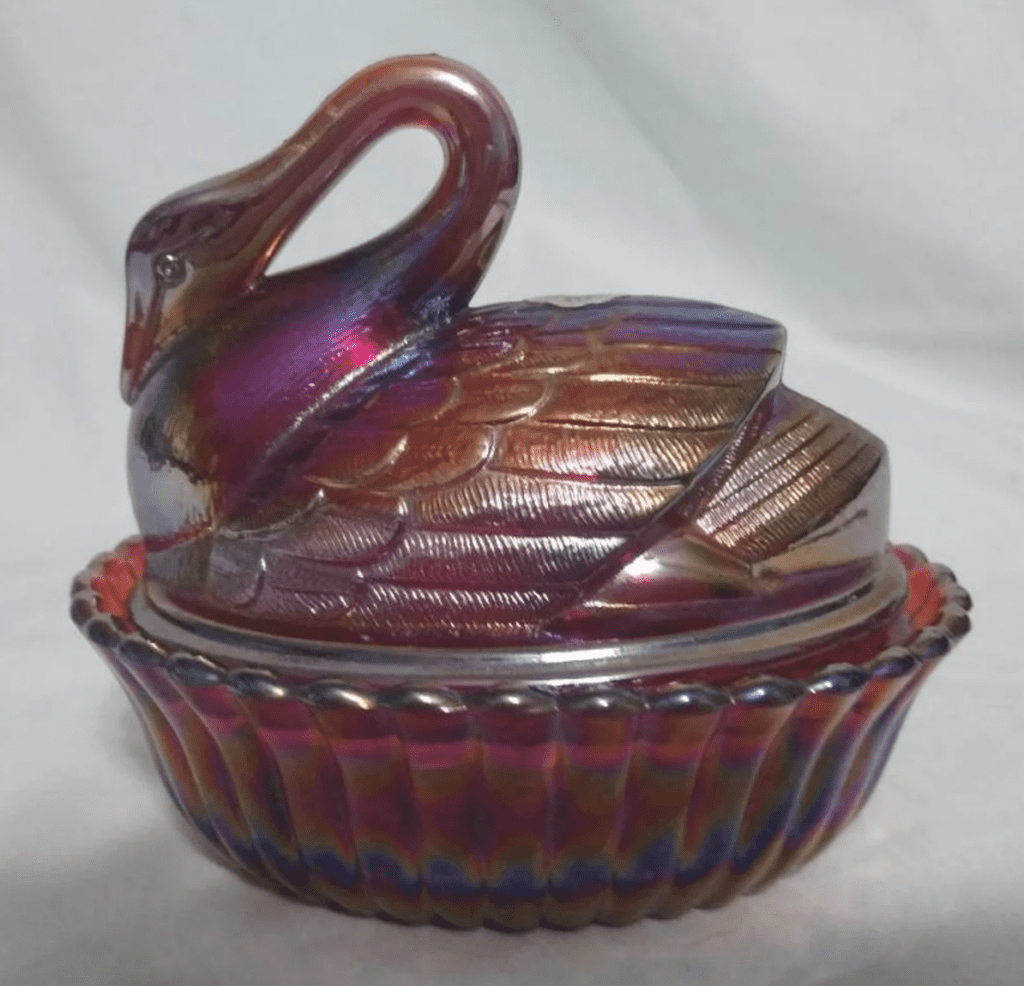
All in all, Carnival glass is beautiful no matter the color. If you own a piece of carnival glass or if you are thinking about buying some, consider the history behind the pieces in addition to the color and the value of each plate or bowl. Though the color might be common, the glaze on the outside and the careful designs and patterns make every piece of carnival glass special.

